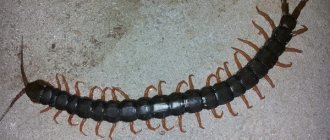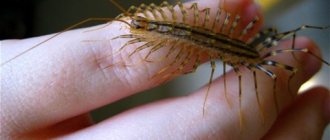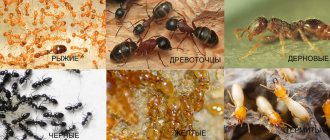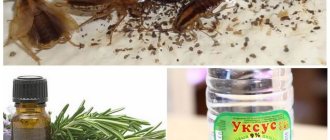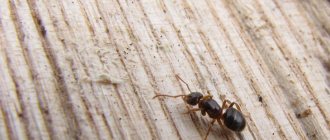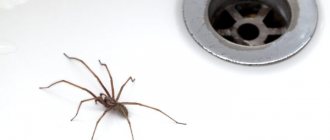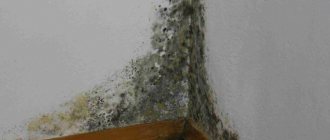The tactics for dealing with centipedes at home and on the street are somewhat different. First, let's put together a guide on how to get rid of house centipedes. To combat house centipedes, there are several very effective approaches that can also be used against other representatives of this superclass - centipedes.
Then we'll talk about how to get uninvited guests out of your garden. And finally, we will select the 5 best remedies that will allow you to forget about the invasion of these creatures.
Who are the centipedes in the house?
Centipedes, millipedes or millipedes are representatives of invertebrates.
Scolopendra.
These are mostly predators that feed on small insects, garden pests, ants, reptiles and even small rodents.
They love warm and humid places, so most of them live in the tropics and subtropics. In Russia they live mainly in the south.
[edit] Classification and taxonomy
For a long time, millipedes were considered as a class or superclass of the subphylum Tracheata
), into which insects were placed as a separate class or superclass.
A certain external similarity with polychaetes allowed some old zoologists to see in centipedes the descendants of onychophorans (hence their second name - prototracheal, that is, they are, as it were, the predecessors of tracheone-breathing animals), which they considered to be descended from polychaetes. Genetic studies, although they confirm the relationship of arthropods with onychophorans (however, the structure and embryonic development of onychophorans show that they are common with Tracheata
traits developed independently through convergent evolution), but rejected their origins in annelids.
Previously considered to be the closest relatives of insects, with which they were combined into the taxon Uniramia
(single-branched, according to the structure of the limbs) or
Atelocerata
(incomplete, according to the nature of the specialization of the head limbs). The last hypothesis has some confirmation from molecular biology data.
Nowadays, some authors believe that centipedes, although they belong to Mandibulata
together with crustaceans and insects, cannot be considered as the closest relatives of the latter.
Mandibulata
hypothesis ,
Myriapoda
is the sister taxon to
Pancrustacea
, a group including crustaceans and
Hexapoda
(insects and their close relatives).
Some scientists even remove millipedes from Mandibulata
and place them closer to
Chelicerata
. Most scientists are still of the opinion that centipedes are either a sister or paraphyletic group in relation to insects.
In the first case, the monophyly of the centipedes themselves is recognized. As synapomorphies, the specifically arranged secondary dissected upper jaws, or mandibles, the structure of which differs from the monolithic single-segmented mandibles of insects and crustaceans, as well as the indicated tendency to diplosegmentation, are indicated. But some signs indicate that diplosegments may also be present in insects ( Dimalata
).
In the 2nd case, centipedes are not recognized as a single, monophyletic group and are distributed among two groups of incomplete antennae - Monomalata
, in which the labiopods and
Collifera
, and
Dimalata
, in which the symphylos and insects are placed.
There are 4 classes of millipedes, the degree of relationship of which to each other is still a matter of debate:
- Labiopods (Chilopoda)
- Dipopods (Diplopoda)
- Pauropoda
- Symphyla
Habitats of centipedes
Insects are ubiquitous in a house or apartment. However, encountering centipedes when the lights suddenly turn on will not be pleasant. Especially considering the speed and impressive views of this animal.
You can meet them:
- In bathroom;
- near a pond;
- under stones;
- in the trunks of rotting trees;
- places where litter is collected;
- compost pits;
- cellars;
- garages.
Solutions
- Cifox – contains cypermethrin. A 50 ml bottle allows you to treat an area of up to 100 square meters to kill insects.
- Get is the most effective tool. A 100 ml bottle is dissolved in a liter of water. This amount is enough to spray a large room, including furniture.
- The executioner is an effective means of fighting. For a two-room apartment you will need 20-25 bottles. One bottle must be diluted with half a liter of water.
- "Cucaracha" is a powerful insecticidal drug. One bottle of 50 ml is enough to treat 100 sq.m.
- "Tetrix" - a remedy for blood-sucking insects. 30 ml of the drug is diluted with a liter of water. The mixture is sprayed or rubbed into surfaces.
- "Butox 50" - used for treating premises. Disinsection is carried out by spraying. Per 100 sq.m. It is necessary to dilute 30 ml of the drug with 10 liters of water.
- "Medilis" is a 25% emulsion concentrate based on the pyrethroid cypermethrin. For 1 sq. m. 50 ml of aqueous emulsion is consumed.
Varieties of centipedes
There are no species of centipedes that are adapted to life in the house. They go there in search of reliable shelter and sufficient food. There are several common species that live in houses and apartments.
This living creature looks unpleasant, it is small, but has thin curved legs. This insect is the leader in movement speed. This is an excellent house cleaner. It feeds on flies, cockroaches, fleas and other small insects.
flycatcher
A large number of species of this insect can be found everywhere. These are predators that actively eat many insects. They are not dangerous to humans, but they can bite unpleasantly and their venom is irritating.
Scolopendra
A little about the species of scolopendra
In total there are more than 90 species of scolopendra. They belong to the family of labiopods. These are long insects, sometimes reaching 15 cm in length, with a segmented body and a large number of legs. Most often, scolopendra is yellowish or brownish in color. On an adult individual, three stripes of bluish or brown color can be found on the back.
https://youtube.com/watch?v=emIZooS9GN4%3Ffeature%3Doembed
In the process of evolution, the first pair of legs at the head of the centipede turned into pincers. It is at their expense that prey is caught. The domestic scolopendra is a predatory creature that actively consumes flies, cockroaches and bedbugs. Leads a nocturnal lifestyle. It can catch several insects at once and eat them for several days.
But if you do get bitten by a scolopendra, be prepared for the following consequences (we’ll warn you right away, not fatal). The bites can be very painful and go away slowly over 1-2 days. The main symptoms that you may experience: at the very moment of the bite there will be a sharp and prolonged pain,
the severity of the pain may vary (from slight to “10” on a 10-point pain scale), body temperature may increase, you may feel severe weakness, most likely, the sensitivity of the skin in the bite area will significantly increase, swelling and redness will appear, and may also loss of sensation and a feeling of numbness may occur.
Scolopendras are somewhat similar to wasps, which do not leave a sting in the wound and can sting a person several times in a row. Often, at the moment of detection by a person, this creature continues to inflict multiple punctures, introducing even more poison. Centipedes usually bite when a person is resting in bed, but they can also crawl into clothes and bite the moment you start getting dressed.
But there is good news: scolopendra bites are not fatal! For a person to die from its poison, he must be bitten by several thousand individuals at the same time!
Helpful advice: if you are bitten by a scolopendra, find a heating pad at home, fill it with moderately hot water (up to 45 degrees C) and apply it to the bite site - this simple measure should bring relief. Scientists have not yet found an explanation for this phenomenon, but they suspect that this is possible due to the fact that some components of scolopendra venom are unstable to heat. The second remedy is ice and analgesics.
And you don’t have to worry about clothes, paper documents, furniture and other items. A centipede is not a moth or a silverfish. She is not at all interested in your things. Another thing is that some centipedes can spoil the air in the house due to the fact that they secrete a bad-smelling secretion - but this is unlikely - there must be too many of these arthropods in your house for you to smell it.
We hope we didn't intimidate you. Therefore, at the end, in order to “whiten up” our heroes a little, let’s tell you how centipedes are useful. They are very active in destroying pests. Their diet includes bedbugs, flies, cockroaches, termites and even spiders. So sometimes centipedes turn into real “guardians of housing” from even more harmful creatures. Therefore, if you are not afraid of such many-legged neighbors, then live with them “in peace and harmony.”
How to get rid of centipedes in the house
If a nimble creature with a huge number of legs that moves almost at lightning speed is noticed in a room when the light suddenly turns on, grabbing a slipper will not help. It’s impossible to keep up with them, and it’s also difficult to kill many of them.
Make your home uncomfortable
The very first rule that will help get rid of centipedes in the house is to make it uncomfortable for them to exist. Here are some ways to help eliminate the settlement of living creatures:
- Remove insects that are of interest to centipedes. No food - no point in living indoors.
Centipede on the site.
- Remove dampness and places of stagnant moisture. High humidity is a comfortable place for animals.
- Monitor the condition of pipes, repair holes, update building materials and paintwork.
- Monitor the state of affairs in the cellar, attic and area, in all places where centipedes can live comfortably.
Traditional methods of getting rid of insects
The problem is that insects are not interested in simple food and will not bite on bait. You can, of course, spray or feed the insects that will become food with chemicals, but this is unlikely.
There are a number of drugs that will help remove centipedes. These baits will make their life unbearable; they act poisonously, even if they touch the body of the centipedes.
Sprinkle in places of residence:
- boric acid;
- Cayenne pepper.
Mechanical method
If possible, the centipede can be caught in a jar or sucked up with a vacuum cleaner. The further future is up to the person to decide - to kill or take the animal outside the site.
A good way to catch animals is sticky tape. It is laid out along the paths along which the scary roommates move. Even 30 pairs of legs will not save the animal from this trap.
Description
Having seen a centipede once, you will no longer confuse it with anything, because its appearance is too memorable.
This arthropod can be yellow, pinkish, gray or brown. An adult specimen measures from 3.5 to 6 cm. Its body is divided into 15 segments and is flattened, thanks to which the centipede is able to crawl into the narrowest crevices. On the sides there are 15 pairs of legs that regenerate when lost, and their length is not the same (the further the pairs of legs are located from the head, the longer they are). The front legs are crowned with tenacious pincers, with which the centipede securely captures its insect victims, after which it injects its poisonous paralyzing secret into them, immobilizing the prey.
Juvenile centipedes (newborns) at this stage of life have only 4 pairs of legs, the number of which increases with each molt.
The centipede sees perfectly in light and in the dark: its compound eyes provide it with excellent vision. The arthropod also runs very quickly on all its legs, which lift its body above the surface while moving, so it is quite difficult to catch it with your hands. When running away, she is able to make sharp turns, while perfectly orienting herself in space thanks to her antennae.
How to get rid of centipedes on your property
Animals that live outside the house will not harm people. Only a meeting with a scolopendra can be dangerous. To deal with them you will need:
Scolopendras are unpleasant neighbors.
- Clean greenhouses and wood storage areas.
- Look in and move large stones and boulders.
- Check silage heaps and compost pits.
- Clear the house of rags and debris.
Is it worth destroying?
If order has been restored on the site and the yard has been cleared, the question will arise whether it is necessary to get rid of the centipedes. They eat garden pests, working for the benefit of gardeners.
There is a version that centipedes are garden pests. But even in the hungriest year, they prefer to move to other places in search of food rather than change their taste preferences.
Interaction with people
Centipedes generally have little impact on human economic or social well-being. At the local level, they can become an agricultural pest.
Centipede bites, burns
They don't bite. Their protective secretions are harmless to humans and usually cause only a slight change in skin color. The secretions of some tropical species can cause pain, itching, local erythema, swelling, blisters, eczema, and cracked skin.
The impact of discharge on the eyes causes general irritation, more serious consequences such as conjunctivitis, keratitis. Called centipede burn. First aid is to thoroughly rinse the area with water. Further treatment is aimed at alleviating local effects.
Pests
Some centipedes are considered household pests, including Xenobolus carnifex, which infects thatched roofs in India, and Ommatoiulus moreleti, which periodically invades apartments in Australia.
Other species exhibit periodic swarming behavior that results in home invasions, crop damage, and train delays when tracks become slippery with the crushed remains of hundreds of centipedes.
They can cause significant damage to crops: the spotted snake millipede (Blaniulus guttulatus) is a known pest of sugar beets and other root crops.
Some large centipedes of the orders Spirobolida, Spirostreptida, Sphaerotheriida are popular as pets.
Some cultures associate the centipede with rain. In Zambia, the crushed insect is used to treat wounds. The Bafians of Cameroon use centipede juice to treat earache.
The indigenous people of Malaysia use their secretions in poisoned arrows. The secretion of Spirobolus bungii was found to stop the division of human cancer cells. People from Burkina Faso eat boiled, dried centipedes in tomato sauce.
Classification
Centipedes do not form a fairly monolithic class, but are divided into groups so different from each other that many zoologists divide the class of millipedes into four different classes. We will consider these groups at the rank of subclasses. The class of centipedes (Myriapoda) is divided into four subclasses, two of which are of greatest importance: 1. Dipopods (Diplopoda); 2. Lipopods (Chilopoda).
Subclass Diplopoda
This largest group includes about 7,200 species of moisture-loving centipedes that live in the forest floor, under fallen trees and in stumps. They, unlike some labiopods, rarely climb tree trunks. Bipeds feed on rotting leaves and decaying wood. Due to their abundance, they bring significant benefits by participating in the mineralization of organic residues: forest litter, dead wood, etc. In our fauna, peculiar centipedes are common - nodule (genus Julus), with an almost round body in cross section, distinguished by a very large number of legs and slow movements. Nozzles, disturbed by something, curl up into a spiral.
Many bipeds have venom glands on the lateral sections of their dorsal scutes. In some tropical species of millipedes, the poison contains hydrocyanic acid; it was once used by Indians to poison arrows.
Subclass Labiopods Chilopoda
A large group (2800 species) of labiopods are represented by active predators, in contrast to all other millipedes, which feed on decaying or living parts of plants. The predation of labiopods is associated with the transformation of the first pair of their trunk legs into grasping jaws equipped with a poisonous gland.
Labiopods, like all centipedes, lead a predominantly secretive nocturnal lifestyle. During the day, you should look for them under fallen leaves and stones, in hollows and under the bark of dead trees, etc. A small (up to 3.2 cm in length) centipede drupe (Lithobius forficatus) is common in our fauna. She has 16 pairs of legs, of which the hind ones are greatly elongated and perform a tactile function. There are rather long antennae on the head.
In the Crimea, the Caucasus and Central Asia, small centipedes with very long limbs, called flycatchers, are found in human habitations (houses). Eyeless centipedes geophiles with a very large number of segments (more than 170) live in the soil, sometimes deep from the surface. Geophilus longicornis is common in our fauna.
The largest of the labiopods, the poisonous centipedes, are widely represented in the tropics. In the Crimea, the Caucasus and Moldova, the ringed scolopendra (Scolopendra cingulata) is found, reaching a length of 10-17 cm. Its bite causes not only severe swelling in humans, but also general poisoning. The temperature rises to 38-39°C, general weakness and headache are observed. However, all painful phenomena go away on their own after 1-2 days. The bite of the Brazilian giant scolopendra (S. gigas) also does not appear to be fatal.
What is it like?
The common centipede got its name for a reason. In her case, everything is obvious - many legs do not go unnoticed. Thanks to this, the arthropod runs very fast. In 1 second she covers up to 40 cm. This allows her to quickly hide when danger appears.
If you carefully examine the centipede, you can find small hairs all over its body, and long antennae on its head. There are also stripes running along the body that extend to the paws. Some people associate the centipede with a scary beetle with a flexible, curved body.
Why is it dangerous?
With the appearance of unusual neighbors, people are interested in why centipedes are dangerous. Apart from its frightening appearance, the common flycatcher is absolutely safe for households or their pets. In addition, the centipede prefers to hunt at night, so many people are not even aware of its existence.
If you try to pick up the centipede with your hands, you will likely experience irritation on the skin. This is due to the fact that the flycatcher’s venom transfers to the skin from the paws. Like insect bites, this can cause some discomfort to a person.
But it is easy to get rid of it by placing the limb under a stream of cold water.
Reproduction, lifespan
The process of reproduction of scolopendra takes several hours, the sacrament is carried out in the dark. The male weaves a kind of cocoon containing sperm. The female draws seminal fluid into her body. After fertilization, egg laying begins within a few weeks; in unfavorable climatic conditions, after several months. On average, a female centipede lays 130 eggs. The development of the young generation of millipedes occurs in close proximity to the female. She holds them all in her paws, dragging them everywhere with her. Small centipedes appear after 3 months. At first, the babies stay with their mother in the nest. And then the most interesting thing happens - a young female can devour her babies or the young can eat their mature mother. It was not possible to establish exactly how long scolopendras live in nature. But in captivity they can live 7 years.
Creating unfavorable conditions for the existence of pests
In order to independently get rid of centipedes in an apartment, it is necessary to create conditions unsuitable for their existence. First of all, deprive them of food - destroy the insects on which they feed, and the flycatchers themselves will leave the home.
Carry out repairs - seal the cracks through which pests enter, repair pipes and sewers. Get rid of excessive dampness: check the ventilation system, install dehumidifiers and regularly ventilate the room. Centipedes are moisture-loving insects and, in the absence of sufficient humidity, will leave the house in search of more comfortable conditions.
To expel flycatchers, get rid of high humidity in your apartment or house. To this end, check the ventilation, regularly ventilate the room or install a dehumidifier
